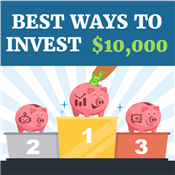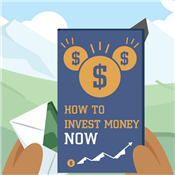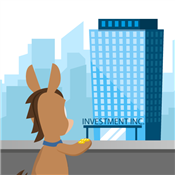The Best Way to Invest $100
$100 may not seem like much, but you can grow it into more. Here are 10+ clever ways to turn $100 into a better future.
 |
| © CreditDonkey |
Here are a few ways to invest your $100:
| Method | Risk | Difficulty |
|---|---|---|
| Robo-Advisors/Micro-Investing | Medium | Very Easy |
| High-Yield Savings Accounts | Very Low | Very Easy |
| Certificates of Deposits | Very Low | Very Easy |
| Retirement Accounts | Low to Medium | Easy |
| ETFs/Index Funds | Low to Medium | Easy |
| College Funds | Low | Easy |
| Individual/Dividend Stocks | Medium to High | Moderate |
| Real Estate | Medium to High | Moderate |
| Peer-to-Peer Lending | Medium to High | Moderate |
| Personal Development | Low | Moderate |
| Start a Business | Low to Medium | Moderate |
| Cryptocurrency | High | Moderate |
Think $100 isn't enough to get you big returns? You may be surprised.
Don't think of it as just a number. Think of it as the start of something bigger. Smart investments can help you turn $100 into a brighter future.
After all, you have to start somewhere. Here are 14 ways to invest your $100, including a few ideas you may not have thought of.
Before You Start Investing
 |
| © CreditDonkey |
Try to be financially secure before you invest. This means doing two things:
- Create an emergency fund
Ideally, you should have 3-6 months of expenses saved up for emergencies. Look for savings accounts that offer high interest. This way, your money can earn compound interest and grow faster in the process.Tip: The average national interest rate for a savings account is 0.45%. Online bank accounts, like those at CIT Bank, can pay up to 4.70%. They usually have no monthly fee and a low minimum deposit, making it a great spot for your emergency fund. - Pay off your debt
Credit card debt will eat away at your investments. Credit cards charge around 20-25% in interest, and it's unlikely for you to find an investment with returns that high.
If you're in good shape with these two things, you're ready to start investing.
No. While starting with more is ideal, $100 is a good start. A great option is to invest in an ETF or index fund, which tracks multiple companies' stocks and offers more diversification than investing in individual stocks.
How and Where to Invest $100
 |
As soon as your financial situation is in shape, you can start investing. Here are 12 ways to invest $100.
Robo Advisors/Micro-Investing
Risk: Medium | Difficulty: Very Easy
Robo advisors automate investing based on your goals and risk tolerance, with some requiring no minimum balance.
Enter your financial goals and risk tolerance, and the robo-advisor's algorithm will select and manage a diversified mix of investments tailored to your preferences.
You can also explore micro-investing apps like Acorns, which round up your everyday purchases and invest the spare change. This allows you to start investing with as little as a few dollars, making it easier to grow your portfolio over time.
Returns on Investment:
Your average potential return for robo advisors and micro-investing depends on the chosen portfolio's risk level and market conditions. Generally:
- Conservative portfolios focus on bonds and offer lower returns but with more stability and less volatility.
- Balanced portfolios are a mix of both stocks and bonds, offering moderate growth potential while managing risk.
- Aggressive portfolios mainly invest in stocks, aiming for higher returns but come with greater risk and volatility.
Pros & Cons:
|
|
High-Yield Savings Accounts
Risk: Very Low | Difficulty: Very Easy
A high-yield savings account offers a safe way to grow your money with almost no risk. For example, with a 2.00% APY, a $10,000 balance could earn $200 in a year.
These accounts typically require low minimum deposits and have minimal fees, making them accessible for any investor.
Returns on Investment:
Interest rates vary depending on the market—as the economy shifts, so do potential earnings.
Generally speaking, this can go as low as 0.45% (the FDIC National Average) and go as high as 4.81% APY (one of the highest rates at the time of writing, offered by Western Alliance Bank).
High-Yield Savings Premier - 4.81% APY
- No account activity or maintenance fees
- $500 minimum opening deposit
- FDIC insured
Pros & Cons:
|
|
Certificates of Deposit (CDs)
Risk: Very Low | Difficulty: Very Easy
A certificate of deposit (CD) is an excellent choice if you want a guaranteed return on your money with very low risk. With a CD, you can lock in your interest rate for a fixed term, ranging from a few months to 5 or 10 years.
Online banks offer some of the best CD rates because they operate with lower overhead costs than traditional banks. This means more of the savings get passed on to you in the form of higher interest.
Returns on Investment:
CD rates depend on the term length and bank. Typically, longer-term CDs (1+ years) offer higher rates than short-term CDs (3-12 months).
Each bank offers different rates with different terms, so be on the lookout for the best CD rates to get the most out of your money.
Pros & Cons:
|
|
Retirement Accounts
Risk: Low to Medium | Difficulty: Easy
Investing $100 in your retirement could grow significantly over time. A smart first step is contributing to your employer's 401(k), especially if they offer matching contributions, which is essentially free money.
Most employers make it simple by automatically withdrawing the contribution from your paycheck.
If you don't have access to a 401(k), you can open a Roth IRA and invest the money yourself. Just note that Roth IRAs have income limits, which can change annually, so you must ensure you're eligible.
Returns on Investment:
The potential return for retirement accounts depends on the investments within them. Generally:
- 401(k) plans typically include mutual or index funds that mirror market performance, offering potential long-term returns.
- Roth IRAs have similar returns, but performance varies based on your chosen assets (stocks, bonds, or mutual funds). Over the long term, stock-heavy portfolios offer higher returns but with more risk.
Pros & Cons:
|
|
ETFs/Index Funds
Risk: Low to Medium | Difficulty: Easy
ETFs are funds that trade like stocks but hold multiple assets, such as stocks, bonds, or futures. They let you invest in entire markets, like the S&P 500, with a single fund.
Essentially, this means instant diversification. Platforms like Stash allow you to start with just a few dollars.
Index funds track specific markets, like the S&P 500, which includes the top 500 U.S. companies. You can invest in index funds through Fidelity or Charles Schwab, which don't require a minimum investment.
Returns on Investment:
Both ETFs and index funds generally follow the market. Historically, returns have been around 7-10%[1] annually, though this can vary based on market conditions.
Pros & Cons:
|
|
College Funds
Risk: Low | Difficulty: Easy
Starting a 529 College Savings Plan is a smart way to save for future education expenses. Even a small contribution now can help reduce student debt later.
With college funds, the key benefit is tax advantages—your investments grow tax-free, and withdrawals for qualified expenses are also tax-free.
Returns on Investment:
Returns vary depending on how the funds are invested, but they often mirror stock or bond market performance. With tax benefits, your overall return on investment is enhanced over time.
Pros & Cons:
|
|
Individual/Dividend Stocks
Risk: Medium to High | Difficulty: Moderate
Thanks to fractional shares, you don't need a large capital to invest in expensive stocks. You can buy a fraction of a share of a big company like Amazon for as little as a few dollars.
Discount brokerages like Robinhood and Stash let you invest in stocks with as little as $1.
Additionally, stable companies that perform well often pay dividends to their stockholders. With a dividend stock, you can reinvest the dividends to buy more shares, allowing you to grow your portfolio over time without additional out-of-pocket investments.
Brokerages like M1 Finance offer commission-free trading for dividend stocks, making it easier to start with no added fees.
Returns on Investment:
Historically, the S&P 500 has delivered an annual return of 7-10%[2] over the long term. Dividends from certain stocks can provide additional income, which can further boost overall returns when reinvested.
Pros & Cons:
|
|
Yes, but it'll depend on the broker you choose and the investment strategy you plan on using. Platforms like Robinhood let you start trading with fractional shares for as little as $1.
Real estate
Risk: Medium to High | Difficulty: Moderate
With Real Estate Investment Trusts (REITs) or crowdfunding platforms like Fundrise, you can invest in properties with as little as $10. These allow you to own a piece of income-generating properties like apartment buildings, commercial real estate, or residential homes.
This means investing in real estate for relatively low amounts without managing the property yourself.
Invest in Real Estate with $10+
- Only $10 minimum investment
- Get a diversified portfolio of real estate projects across the US
- Open to all investors
Returns on Investment:
Real estate returns vary depending on the market and the type of properties involved. Generally speaking, you could earn between 7-12% using crowdfunding platforms.
For example, Fundrise investors see an average return of 2.2% after one year. However, long-term growth is strong, with returns averaging 40.1% by 5 years and 69.3% after 8 years, driven by rental income and property appreciation.[3]
Pros & Cons:
|
|
Peer-to-Peer Lending
Risk: Medium to High | Difficulty: Moderate
Peer-to-peer lending allows you to lend money through platforms like Prosper and Kiva, starting with just $25 per loan.
Lending to multiple borrowers diversifies your risk while potentially earning higher returns than savings accounts. These platforms handle the process of rating borrowers to help you make informed decisions.
Returns on Investment:
Returns range from 5-9%, depending on borrower risk and platform.[4]
Pros & Cons:
|
|
Personal Development
Risk: Low | Difficulty: Moderate
Investing in yourself is one of the most valuable investments you can make, as it can significantly boost your earning potential and personal growth.
With just $100, you can enhance your skills, knowledge, or health, leading to long-term benefits.
Here are a few ways to invest in your personal development:
- Take online courses
Platforms like Udemy or Skillshare offer affordable courses to learn new skills or deepen existing ones, which could lead to career advancement or new income streams. - Find a mentor
Coaching sessions from industry professionals can help you gain insights and direction for personal or professional growth. - Invest in your health
Buying quality exercise gear, like shoes, supports your physical health, improving energy, productivity, and overall well-being.
Returns on Investment:
The return on personal development investments varies, but the potential is high. In some cases, learning a new skill could lead to a significant increase in income or a new career path.
Health-related investments can improve productivity and quality of life, offering less tangible but valuable returns.
Pros & Cons:
|
|
Start a Business
Risk: Low to Medium | Difficulty: Moderate
Starting a business today doesn't require a huge investment—$100 can be enough to cover essentials like website hosting, a professional logo, or a subscription to e-commerce platforms like Shopify.
Your business can encompass anything from cleaning neighbors' houses, pet-sitting, and blogging with affiliate marketing to becoming a virtual assistant or personal concierge.
Another low-cost business option is flipping items for profit. If you have a keen eye, you can find valuable items at estate sales or Craigslist, fix them up, and sell them for a higher price. This side hustle has little overhead and can be done in your free time.
Look for pieces of furniture, exercise equipment, musical instruments, or power tools that you can fix up and resell.
Returns on Investment:
Returns will vary depending on the business you choose.
Your upfront investment can quickly turn into a steady income for services like cleaning or pet sitting. Depending on the product and market, flipping items can yield anywhere from 30-100% profits or more, especially if you find valuable items at low cost.
Pros & Cons:
|
|
Cryptocurrency
Risk: High | Difficulty: Moderate
Cryptocurrency offers a chance to invest in the growing world of blockchain technology. Start by researching popular coins like Bitcoin and Ethereum, then purchasing through a beginner-friendly app or exchange.
To enhance security, consider storing your crypto in a crypto wallet and use a portfolio tracker to monitor your investments.
Returns on Investment:
Returns can be extremely volatile. Cryptocurrencies have seen massive gains but are also prone to steep losses, making them high-risk, high-reward investments.
Before you start investing, make sure you understand the risks.
Pros & Cons:
|
|
How $100 Can Add Up to Big Money
With compound interest, you earn interest on both your initial $100 and the interest it generates. Over time, this "interest on interest" can lead to significant growth.
Regularly contributing to your investment, even small amounts, increases the total that earns interest. The longer you invest, the more your money grows.
For example, investing $100 at a 7% annual return can grow to over $113,000 in 30 years. Starting early and being consistent can turn small savings into substantial wealth.
Yes, investing $100 a month is worth it. Thanks to compounding interest, even small contributions can grow significantly over time. For example, if you invest $100 monthly with an average annual return of 6-8%, you could have over $40,000 in 20 years.
Investment Calculator
Want to know how much you can earn with your investment? This calculator will show you how much your investment will grow, how much you'll earn in total (and per year), and how much of your ending balance is interest vs. contributions. Here's how to use it:
- Enter your initial investment.
- Input how much you're contributing.
- Specify how long you're growing your investment.
- Enter the interest rate.
- Define the compound frequency.
From there, click "Calculate." You'll see your end balance, total interest earned, and total contribution amount.
Investments to Avoid
These types of "investments" may not help you build wealth and could put your money at risk:
- Pyramid schemes: These rely on recruiting new members to pay existing ones, which becomes unsustainable as the scheme grows. If you're asked to pay to join and recruit others, it's wise to be cautious of a pyramid scheme.
- Get-rich-quick-schemes: Promises of high returns with little effort sound appealing, but they typically come with high risk and little reward. Be cautious of offers that seem too good to be true.
- Gambling: Putting your money into gambling is risky, as the odds are usually stacked in favor of the house. It's better to keep your money in safer investments.
- Lottery tickets: While buying a ticket might be fun, the odds of winning the jackpot are extremely low. It's fine for entertainment but not as a wealth-building strategy.
What the Experts Say
As part of our series on investing, CreditDonkey asked a panel of industry experts to answer some of the readers' most pressing questions. Here's what they had to say:
Bottom Line
No matter where you are in your financial journey, that $100 can be a powerful tool. Whether you use it to build an emergency fund, pay off debt, invest for growth, or develop new skills, the key is to start now.
Even small steps can lead to big rewards over time. The most important thing is to take action—let that $100 be the beginning of your financial success. One day, you'll be glad you made that choice.
References
- ^ Official Data. S&P 500 Data, Retrieved 10/11/2024
- ^ Curvo. Historical performance of the S&P 500 index, Retrieved 10/08/2024
- ^ Fundrise. Consistent growth over time, Retrieved 10/10/2024
- ^ Bankrate. Red Flags of Peer-to-Peer Lending, Retrieved 10/10/2024
Write to Kim P at feedback@creditdonkey.com. Follow us on Twitter and Facebook for our latest posts.
Note: This website is made possible through financial relationships with some of the products and services mentioned on this site. We may receive compensation if you shop through links in our content. You do not have to use our links, but you help support CreditDonkey if you do.
Fundrise, LLC ("Fundrise") compensates CreditDonkey Inc for new leads. CreditDonkey Inc is not an investment client of Fundrise.
|
|
| ||||||
|
|
|
















